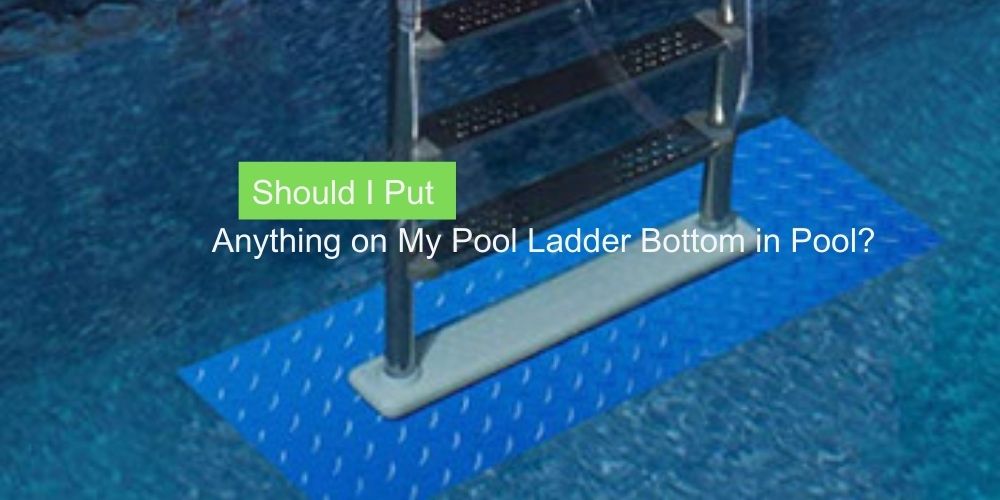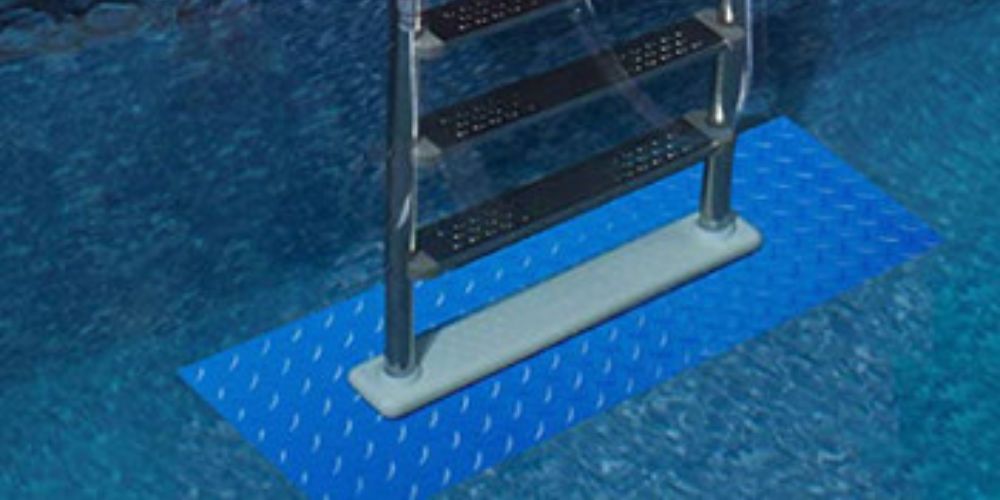
When it comes to pool ladder bottom in pool, ensuring the safety and longevity of your pool ladder is crucial. A general question pool owners have is whether they should put anything on the bottom of their pool ladder. This post will explore the importance of pool ladder bottom protection, discuss the types of coverings available, and provide guidance on selecting the right coverage for your pool ladder.
Should I Put Anything on My Pool Ladder at the Bottom of the Pool?

Putting anything on the bottom of your pool ladder in the pool itself is generally unnecessary. The ladder is designed to be used directly in the water without any additional materials.
If you are concerned about the ladder slipping or scratching the pool surface, you could consider using non-slip adhesive strips or pool ladder bumpers specifically designed for this purpose.
It’s always a good idea to consult the manufacturer’s instructions or contact a pool professional for guidance tailored to your specific ladder and pool type.
3 Types of Pool Ladder Bottom Coverings You Can Use
1. Rubber Bumpers
Rubber bumpers are a popular choice for pool ladder bottom protection. They provide cushioning, reducing the impact on the ladder and the pool surface. Rubber bumpers are easy to install and can be found in various sizes to fit different ladder models.
2. Vinyl Sleeves
Vinyl sleeves offer a protective layer covering the entire ladder’s bottom portion. They are often secured with Velcro or straps and provide excellent resistance to corrosion and scratches.
Vinyl sleeves are available in different colors and designs, allowing you to personalize the look of your ladder.
3. Non-Slip Mats
Non-slip mats are an alternative pool ladder bottom protection option. These mats provide grip and prevent slipping accidents when entering or exiting the pool. They are usually made from durable materials like rubber or PVC and can be easily cleaned.
4 Advantages of Using Pool Ladder Bottom Coverings
- Enhanced Safety: Covering the bottom of your pool ladder reduces the risk of injuries caused by sharp edges or slippery surfaces.
- Extended Lifespan: By protecting the ladder bottom from scratches and corrosion, the coverings help prolong the ladder’s lifespan.
- Aesthetic Appeal: Many pool ladder bottom coverings come in different colors and designs, adding a visually appealing touch to your pool area.
- Comfortable Experience: Rubber bumpers and non-slip mats provide a more comfortable grip, making climbing in and out of the pool easier and safer.
Step-by-Step Guide: Applying a Pool Ladder Bottom Covering
- Clean the ladder: Thoroughly clean the ladder bottom, removing any dirt, debris, or existing coverings.
- Measure and cut: Measure the dimensions of the ladder bottom and cut the covering material accordingly.
- Attach the covering: Securely attach the covering to the ladder, following the manufacturer’s instructions. Ensure it is firmly in place.
- Test and adjust the ladder to ensure the covering is properly installed and adjust if necessary.
Maintenance and Cleaning of Pool Ladder Bottom Coverings
To maintain and clean your pool ladder bottom covering, follow these steps:
1. Regular cleaning
Periodically clean the covering to remove dirt, debris, and any chemical residues. Use mild soap and water for gentle cleaning. Avoid using abrasive cleaners, as they can damage the covering.
2. Gentle scrubbing
If stubborn stains or grime are on the covering, gently scrub it with a soft-bristle brush or sponge. Again, avoid using harsh abrasives that can scratch or degrade the material.
3. Rinse thoroughly
Rinse the covering thoroughly with clean water to remove any soap residue. Ensure that all cleaning agents are completely washed away.
4. Air drying
Allow the covering to air dry completely before reattaching it to the pool ladder. This will help prevent any moisture buildup or mold growth.
5. Inspection for damage
Regularly inspect the covering for any signs of wear, tear, or damage. Look for cracks, fraying edges, or loose attachments. If you notice any damage, consider replacing the covering to maintain optimal protection.
FAQs: Should I Put Anything on My Pool Ladder Bottom in Pool?
1. Do you put sand in the pool ladder?
No, you do not typically put sand in a pool ladder. Pool ladders are designed to provide stability and support for swimmers entering and exiting the pool.
2. What can you put under a pool ladder to protect the liner?
To protect your pool’s liner, you can place a pool ladder mat or pad under the pool ladder. These mats or pads are specifically designed to provide a protective barrier between the pool ladder and the pool liner. They help prevent abrasion, scratching, and damage to the liner caused by the ladder’s contact.
3. What do you put between pool and sand?
To provide an additional layer of protection between the pool liner and the sand base, you can use a product called Armor Shield Floor Pad. This floor pad is specifically designed to act as a protective barrier, preventing cuts, punctures, and damage to vinyl swimming pool liners.
4. Do pool ladders rust?
Yes, pool ladders can rust over time, especially if they are not made from rust-resistant materials or if they are not properly maintained. Pool ladders are constantly exposed to water, chemicals, and elements, which can cause corrosion and rusting.
5. How do I keep my pool ladder from rusting?
To prevent pool ladder rusting, regularly clean and dry the ladder, apply a protective coating, and promptly address any signs of rust or damage.
6. What is the green stuff on my pool ladder?
The green stuff on your pool ladder is most likely algae growth, which can occur due to the presence of moisture and warm conditions. Algae thrive in damp environments and can cling to various surfaces, including pool ladder surfaces. Regular cleaning and maintenance, including brushing and treating your pool with appropriate chemicals, can help prevent and remove algae growth on your pool ladder.
Wrap Up
Protecting the bottom of your pool ladder is essential for maintaining safety and prolonging its lifespan. With various options available, such as rubber bumpers, vinyl sleeves, and non-slip mats, you can choose a covering that suits your needs and enhances your pool experience.
Remember to select a durable covering, install it properly, and perform regular maintenance to ensure its effectiveness.

Hi, This is Josh. I am a former competitive swimmer and current fitness enthusiast.
I created this site to share my love of swimming with the world!
